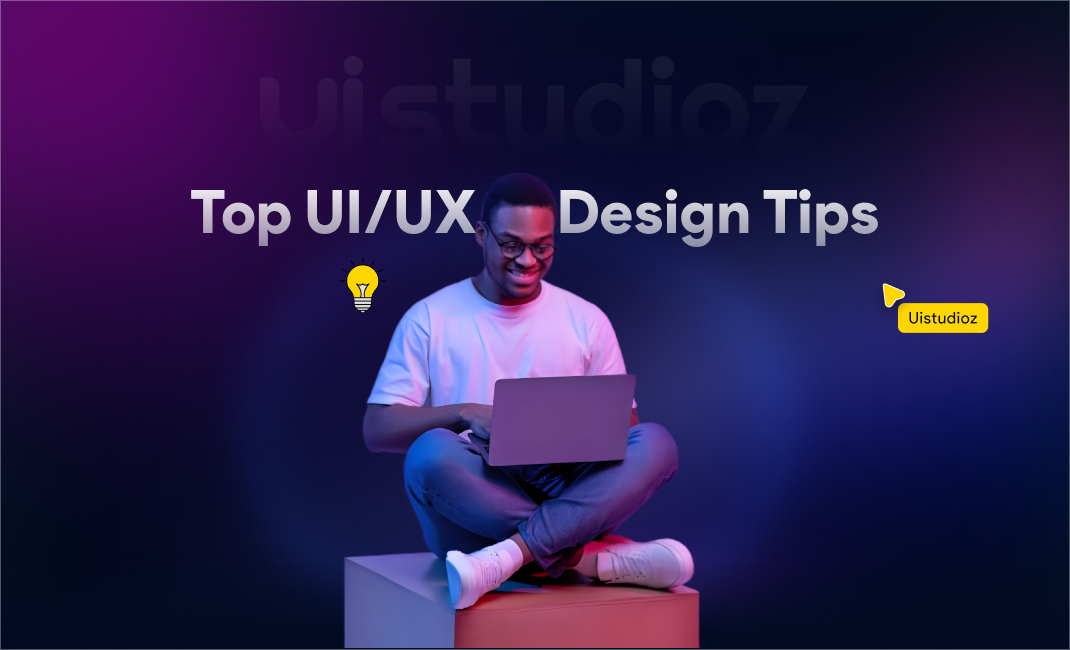Top UI/UX Design Tips To Follow in 2025

As we enter 2025, the UI/UX design world continues to evolve. Whether you’re a seasoned designer or starting, staying on top of the latest trends and best practices is crucial.
This post will explore the top UI/UX design tips to help you create outstanding digital experiences this year.
Before we start, here are some UI/UX design statistics to consider:
1. According to a study by Adobe, 38% of users will stop engaging with a website if the content or layout is unattractive.
2. The same study found that 59% of people prefer to engage with beautifully designed content rather than simple, plain content.
3. Google research shows that 53% of mobile site visitors leave a page that takes longer than three seconds to load.
4. A survey by Clutch revealed that 94% of users’ first impressions of a website are design-related.
5. According to UX Booth, users form opinions about a website’s credibility in as little as 50 milliseconds.
Prioritize User Experience: 10 Exclusive UI/UX Design Tips For Creative Designers
1. Prioritize Accessibility
Gone are the days when accessibility was an afterthought. In 2025, it will be a must-have for any successful design.
Tips:
– Use high-contrast color schemes
– Implement keyboard navigation
– Add alt text to images
– Ensure your designs work with screen readers
Did you know that, according to the World Health Organization, over 1 billion people worldwide live with some form of disability? Making your designs accessible isn’t just good practice—it’s essential for reaching a wider audience.
2. Embrace Minimalism
In 2025, less is more. Minimalist designs are visually appealing and improve user experience by reducing cognitive load.
How to achieve minimalism:
– Use white space effectively
– Stick to a limited color palette
– Choose simple, clean typography
– Remove unnecessary elements
3. Focus on Micro-interactions
Small, subtle animations can make a big difference in user engagement. Micro-interactions provide instant feedback and make your interface feel more alive.
Examples of micro-interactions:
– Button hover effects
– Loading animations
– Transition effects between screens
– Subtle feedback for form inputs
4. Prioritize Mobile-First Design
With mobile usage continuing to rise, designing for smaller screens should be your starting point.
Benefits of mobile-first design:
– Improved performance on all devices
– Better user experience for mobile users
– Easier scaling up to larger screens
– Forced focus on essential features
Did you know? As of 2023, mobile devices accounted for 59.4% of global website traffic. This number is expected to grow in 2025 and beyond.
5. Implement Dark Mode
Dark mode isn’t just a passing trend. It’s here to stay, and users love it.
Advantages of dark mode:
– Reduced eye strain in low-light conditions
– Potential battery savings on OLED screens
– Aesthetic appeal for many users
– Improved readability for some content types
6. Use Data to Inform Design Decisions
In 2025, gut feelings aren’t enough. Use data and analytics to make informed design choices.
Ways to incorporate data:
– Conduct user testing
– Analyze heatmaps and click patterns
– Review user feedback and surveys
– A/B test different design elements
7. Create Personalized Experiences
Users expect tailored experiences in 2025. Use data and AI to create designs that adapt to individual preferences.
Personalization ideas:
– Customizable dashboards
– Content recommendations based on user behavior
– Adaptive color schemes
– Personalized onboarding experiences
8. Prioritize Voice User Interface (VUI) Design
With the rise of smart speakers and voice assistants, designing for voice interactions is becoming increasingly important.
VUI design tips:
– Keep voice commands simple and natural
– Provide clear feedback for voice inputs
– Consider context in voice interactions
– Design for accessibility in voice interfaces
9. Implement Augmented Reality (AR) Features
AR is no longer just for gaming. By 2025, it will be a valuable tool for enhancing user experiences across various industries.
Potential AR applications:
– Virtual try-ons for e-commerce
– Interactive product demonstrations
– Enhanced navigation in physical spaces
– Immersive educational experiences
10. Focus on Storytelling in Design
Incorporate storytelling elements into your designs to engage users. This creates emotional connections and enhances the overall user experience.
Ways to incorporate storytelling:
– Use progressive disclosure to reveal information
– Create a cohesive visual narrative
– Use illustrations and animations to convey concepts
– Craft compelling microcopy
Conclusion:
As we navigate 2025, these UI/UX design tips will help you create more engaging, accessible, and user-friendly digital experiences. Remember, great design is more than aesthetics—creating meaningful interactions that solve real user problems.
Whether you’re a UI/UX designer looking to improve your skills or a business owner considering hiring one, keeping these trends and best practices in mind will set you up for success in the ever-evolving digital landscape.
How often should I update my UI/UX design?
While there’s no fixed rule, reviewing and updating your designs at least once a year is good practice. This will help you stay current with design trends and user expectations.
Do I need to hire a UI/UX designer for my project?
Hiring a UI/UX designer is a wise investment if you want a professional, user-friendly design. They bring expertise in user research, interaction design, and visual design.
What’s the difference between UI and UX design?
UI (User Interface) design focuses on the visual elements users interact with. UX (User Experience) design is broader, encompassing the entire user journey and how it feels to use a product.
How can I measure the success of my UI/UX design?
Key metrics include user engagement, conversion, task completion, and user satisfaction scores. Use analytics tools and user feedback to gauge success.
What tools do UI/UX designers use in 2025?
Popular tools include Figma, Sketch, Adobe XD, InVision, and Axure. However, the best tool depends on your specific needs and workflow.
